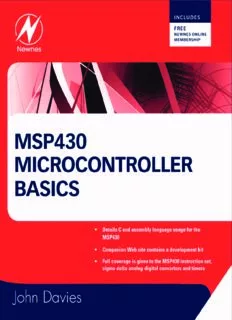
MSP430 Microcontroller Basics PDF
Preview MSP430 Microcontroller Basics
MSP430 Microcontroller Basics Thispageintentionallyleftblank MSP430 Microcontroller Basics John H. Davies AMSTERDAM•BOSTON•HEIDELBERG•LONDON NEWYORK•OXFORD•PARIS•SANDIEGO SANFRANCISCO•SINGAPORE•SYDNEY•TOKYO NewnesisanimprintofElsevier NewnesisanimprintofElsevier 30CorporateDrive,Suite400,Burlington,MA01803,USA LinacreHouse,JordanHill,OxfordOX28DP,UK Copyright©2008,ElsevierLtd.Allrightsreserved. Nopartofthispublicationmaybereproduced,storedinaretrievalsystem,ortransmittedinanyform orbyanymeans,electronic,mechanical,photocopying,recording,orotherwise,withouttheprior writtenpermissionofthepublisher. PermissionsmaybesoughtdirectlyfromElsevier’sScience&TechnologyRightsDepartmentinOxford, UK:phone:(+44)1865843830,fax:(+44)1865853333,E-mail:[email protected] alsocompleteyourrequestonlineviatheElsevierhomepage(http://www.elsevier.com)byselecting “Support&Contact”then“CopyrightandPermission”andthen“ObtainingPermissions.” Recognizingtheimportanceofpreservingwhathasbeenwritten,Elsevierprintsits booksonacid-freepaperwheneverpossible. LibraryofCongressCataloging-in-PublicationData Applicationsubmitted BritishLibraryCataloguing-in-PublicationData AcataloguerecordforthisbookisavailablefromtheBritishLibrary. ISBN:978-0-7506-8276-3 ForinformationonallNewnespublications, visitourWebsiteat:http://www.books.elsevier.com 08 09 10 11 12 13 10 9 8 7 6 5 4 3 2 1 PrintedintheUnitedStatesofAmerica “ToElizabeth.” Thispageintentionallyleftblank Contents Preface........................................................................... xi Chapter1:EmbeddedElectronicSystemsandMicrocontrollers ................... 1 1.1 What(andWhere)AreEmbeddedSystems? .................................... 1 1.2 ApproachestoEmbeddedSystems............................................... 2 1.3 SmallMicrocontrollers ........................................................... 5 1.4 AnatomyofaTypicalSmallMicrocontroller.................................... 8 1.5 Memory........................................................................... 11 1.6 Software..........................................................................15 1.7 WhereDoestheMSP430Fit?...................................................16 Chapter2:TheTexasInstrumentsMSP430 .....................................21 2.1 TheOutsideView—Pin-Out ....................................................21 2.2 TheInsideView—FunctionalBlockDiagram..................................24 2.3 Memory...........................................................................25 2.4 CentralProcessingUnit..........................................................30 2.5 Memory-MappedInputandOutput.............................................32 2.6 ClockGenerator..................................................................33 2.7 Exceptions:InterruptsandResets...............................................36 2.8 WheretoFindFurtherInformation .............................................37 Chapter3:Development.........................................................43 3.1 DevelopmentEnvironment......................................................44 3.2 TheCProgrammingLanguage..................................................46 3.3 AssemblyLanguage..............................................................55 3.4 AccesstotheMicrocontrollerforProgrammingandDebugging..............57 3.5 DemonstrationBoards...........................................................59 3.6 Hardware .........................................................................64 3.7 Equipment........................................................................65 www.newnespress.com viii Contents Chapter4:ASimpleTouroftheMSP430.......................................67 4.1 FirstProgramonaConventionalDesktopComputer..........................68 4.2 LightLEDsinC .................................................................70 4.3 LightLEDsinAssemblyLanguage.............................................72 4.4 ReadInputfromaSwitch .......................................................80 4.5 AutomaticControl:FlashingLightbySoftwareDelay ........................91 4.6 AutomaticControl:UseofSubroutines.........................................99 4.7 AutomaticControl:FlashingLightbyPollingTimer_A......................105 4.8 HeaderFilesandIssuesBrushedundertheCarpet............................114 Chapter5:ArchitectureoftheMSP430Processor .............................119 5.1 CentralProcessingUnit.........................................................119 5.2 AddressingModes ..............................................................125 5.3 ConstantGeneratorandEmulatedInstructions................................131 5.4 InstructionSet...................................................................132 5.5 Examples ........................................................................146 5.6 ReflectionsontheCPUandInstructionSet ...................................153 5.7 Resets............................................................................157 5.8 ClockSystem....................................................................163 Chapter6:Functions,Interrupts,andLow-PowerModes .......................177 6.1 FunctionsandSubroutines .....................................................178 6.2 WhatHappenswhenaSubroutineIsCalled? .................................178 6.3 StorageforLocalVariables.....................................................179 6.4 PassingParameterstoaSubroutineandReturningaResult..................183 6.5 MixingCandAssemblyLanguage ............................................185 6.6 Interrupts ........................................................................186 6.7 WhatHappenswhenanInterruptIsRequested? ..............................188 6.8 InterruptServiceRoutines......................................................190 6.9 IssuesAssociatedwithInterrupts...............................................196 6.10 Low-PowerModesofOperation...............................................198 Chapter7:DigitalInput,Output,andDisplays.................................207 7.1 DigitalInputandOutput:ParallelPorts .......................................208 7.2 DigitalInputs....................................................................216 7.3 SwitchDebounce ...............................................................225 7.4 DigitalOutputs..................................................................238 7.5 Interfacebetween3Vand5VSystems.........................................243 7.6 DrivingHeavierLoads..........................................................247 7.7 LiquidCrystalDisplays.........................................................252 7.8 DrivinganLCDfromanMSP430x4xx........................................256 7.9 SimpleApplicationsoftheLCD ...............................................264 www.newnespress.com Contents ix Chapter8:Timers..............................................................275 8.1 WatchdogTimer.................................................................276 8.2 BasicTimer1 ....................................................................281 8.3 Timer_A.........................................................................287 8.4 MeasurementintheCaptureMode ............................................300 8.5 OutputintheContinuousMode................................................318 8.6 OutputintheUpMode:Edge-AlignedPulse-WidthModulation ............330 8.7 OutputintheUp/DownMode:CenteredPulse-WidthModulation ..........349 8.8 OperationofTimer_AintheSamplingMode.................................352 8.9 Timer_B .........................................................................353 8.10 WhatTimerWhere?.............................................................356 8.11 SettingtheReal-TimeClock:StateMachines.................................357 Chapter9:Mixed-SignalSystems:AnalogInputandOutput....................369 9.1 Comparator_A...................................................................371 9.2 Analog-to-DigitalConversion:GeneralIssues ................................393 9.3 Analog-to-DigitalConversion:SuccessiveApproximation...................402 9.4 TheADC10Successive-ApproximationADC.................................407 9.5 BasicOperationoftheADC10.................................................412 9.6 MoreAdvancedOperationoftheADC10 .....................................424 9.7 TheADC12Successive-ApproximationADC.................................432 9.8 Analog-to-DigitalConversion:Sigma–Delta..................................438 9.9 TheSD16_ASigma–DeltaADC...............................................446 9.10 OperationofSD16_A...........................................................459 9.11 SignalConditioningandOperationalAmplifiers..............................475 9.12 Digital-to-AnalogConversion..................................................485 Chapter10:Communication....................................................493 10.1 CommunicationPeripheralsintheMSP430...................................495 10.2 SerialPeripheralInterface......................................................497 10.3 SPIwiththeUSI ................................................................504 10.4 SPIwiththeUSCI ..............................................................513 10.5 AThermometerUsingSPIinMode3withtheF2013asMaster.............520 10.6 AThermometerUsingSPIinMode0withtheFG4618asMaster...........526 10.7 Inter-integratedCircuitBus ....................................................534 10.8 ASimpleI²CMasterwiththeUSCI_B0onaFG4618........................542 10.9 ASimpleI²CSlavewiththeUSIonaF2013..................................549 10.10 StateMachinesforI²CCommunication .......................................559 10.11 AThermometerUsingI²CwiththeF2013asMaster .........................567 10.12 AsynchronousSerialCommunication .........................................574 10.13 AsynchronousCommunicationwiththeUSCI_A.............................581 www.newnespress.com
Description: